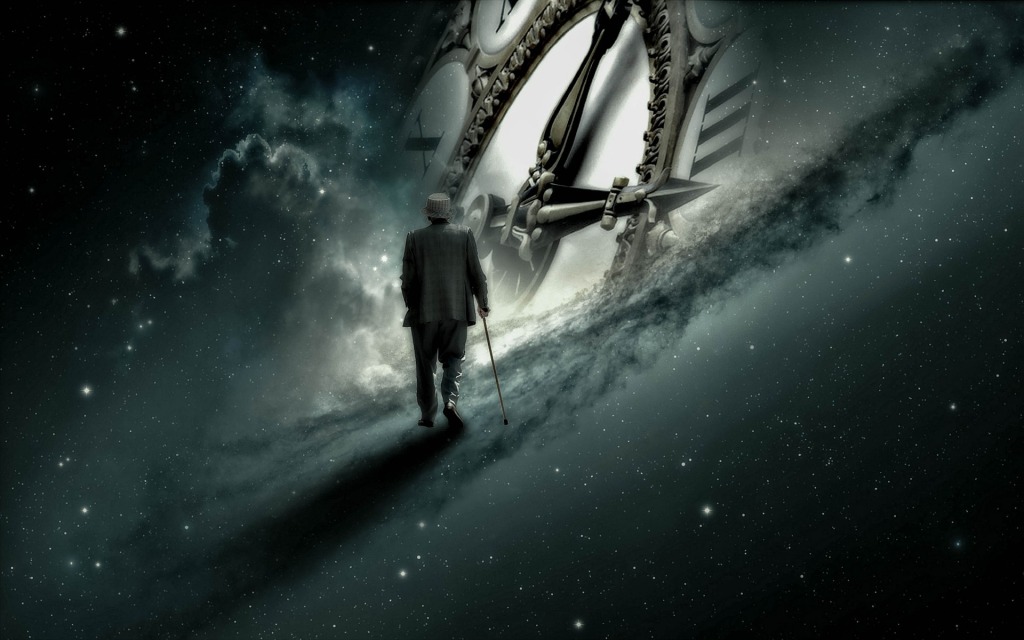
Einstein’s theory of relativity tells us that we live in a sort of spacetime continuum. The cosmos we recognize is not only a spatial entity but also a time sequence that contains itself.
We can easily understand such “reality” with a few thought experiments. For example, the sunlight we see right now is not the sunlight “right now,” but what took place around eight minutes ago as it took time to travel to reach our eyes.
Because of a distance (space), there is always a time gap between what we see and ourselves. The same logic should be at any levels. Even an apple before you, for instance, is the apple that existed in the past as its light traveled to reach your eyes, strictly speaking.
Everything we see should be in the past as long as there is a space between what we see and ourselves. Put it bluntly, we can never live “here and now.” When there is a space, there is a time. Both are the same attributes as far as the dimensions are concerned.
The same logic should be at the macro level as well. The farther we see, the older we reach. The light from the Andromeda Galaxy is approximately 2.5 million light-years from the Earth. In the same manner, therefore, the Andromeda Galaxy we see “right now” is the Andromeda Galaxy that existed 2.5 million years ago. We can never see and know what’s happening there “right now.”
If the universe exists this way, we can also think of its beginning, the Big Bang. If there could be a sort of the universe’s ultimate edge that the light can reach us, this very edge should be the cosmos inception.
The size of the universe is the age of the universe.
According to astrophysicists and cosmologists, the universe’s age and size used to be on 13.8 billion light-years. However, the recent studies show that the comoving distance to the edge of the observable universe is about 46.6 billion light-years, its diameter is about 93 billion light-years due to the Hubble expansion.
I’m not sure if the further updates would take place near future. After all, all these kinds of articulations can never be free from our cognitive limitations as they are “our articulations.” Whatever astronomical numbers they newly present as the “latest findings,” these are also never free from the future updates. As we get smarter, we could see more. Still, there should be aways what we can never see as long as we are the ones who articulate them for ourselves.
What are the age and size of the universe? As long as we provide the information about them, we inevitably have to see something unknown. Saying the observable universe in itself also implies a glimpse of something unobservable, and something unsayable. Saying something unknown and unobservable implies that there is “something” beyond what we can signify as unknown, unobservable, and unsayable.
We don’t know what we don’t know.
Minkowski’s spacetime model is one of the intriguing articulations to indicate such a limit to our observability. It is one of the models that mathematician, Hermann Minkowski proposed to visualize the spacetime continuum of Einstein’s theory of relativity.
For example, a three-dimensional spatial entity’s visual presentation consists of three axes of x, y, and z. They represent the horizontal, vertical, and depth axes, respectively. And as the theory of relativity says, there is another axis that represents time as t. So, in reality, we live in the four-dimensional universe of x, y, z, and t.
While we can “sense” the movement of time (though we have to be cautious about this signification concerning our consciousness), we can’t “visualize” it as is. To do so, therefore, we have to convert it into a three-dimensional scale. A calendar or timetable is a typical example.
Similarly, Minkowski’s model collapses the height and convert the x, y, z space into the flat two-dimensional plane, and add the “vertical” t axis to represent the time scale. Then, not only the time, but it can also visualize the velocity at the coordinates between the flat, x, y, z plane, and the vertical t time scale. This way, setting each axis’s measures, the model can indicate the speed of light as the forty-five degree of velocity.
Considering E is the “here and now” point that we exist, a spatial entity is the flat two-dimensional plane, a time entity becomes the vertical axis. In doing so, the spacetime continuum can be a kind of cone shape as follows, called a “light cone.”

As you noticed, there are two light cones to represent the past and the future. The lower light cone means our past spacetime. As mentioned above, the farther we see, the older the past we could recognize. In this portion, we can understand the size and age of the universe. And beyond the speed of light, meaning outside the light cone, we can never see anything.
The upper light cone, on the other hand, represents our future spacetime. What does it mean? Let’s say, the light shines “here and now” at the point of E will reach someday to the future observers’ eyes. Therefore, the upper light cone implies the future potential spacetime, and yet again, the potentiality could never transcend the speed of light.
In the multiple universes, someone in the future world would see us just like seeing the past people far way, even the cosmos edge. Still, the spacetime that those “future” people would see can never transcend the upper light cone’s shape.
Minkowski’s spacetime is an intriguing model that tells us what we can know and can’t. It is a sort of “calendar” or “timetable” (as time is spatial) that indicates the spacetime limits by itself. Moreover, it also shows that the limit of the universe is on the boundary of the light speed. Beyond the light, therefore, there is no such thing as spacetime.

Images by Willgard Krause and Yatheesh Gowda